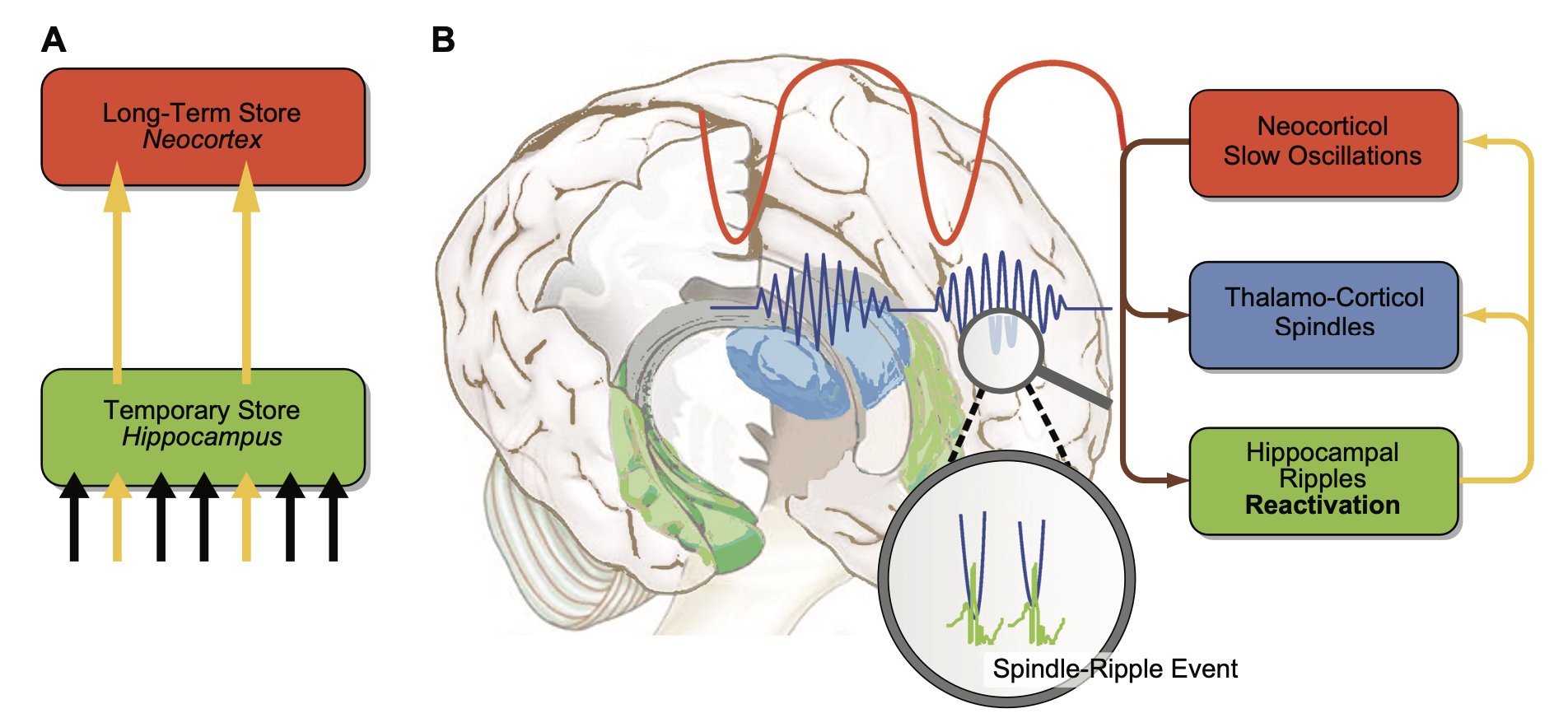To Sleep, Perchance to Learn
Image by Daniela Dimitrova from Pixabay
What body organs and systems never take a rest? The list starts with the heart, certainly. The lungs as well. I doubt your list includes the brain, but it should. Wait! The brain is unconscious when we sleep, isn’t it? When we sleep, our heart and respiration rates slow, but don’t stop. Ditto for most other vital processes. The brain sleeps too, doesn’t it?
The brain is always active; it never sleeps!
During sleep the brain moves to a different type of activity that is at least equally as strenuous as that demanded of the waking brain. Waking brains are bombarded with sensory information, most of which they ignore; a very small percentage is sent on to working memory for possible encoding in the form of concepts. None of these encoded concepts will survive to see the light of day unless they are stabilized and stored in long-term memory. These latter processes are collectively called consolidation.
To consolidate is to unify or to create a coherent whole. (OED)
The human brain specializes in pattern formation. Floating facts will probably expire overnight if they don’t find a logical home in a pattern. In contrast, concepts (which are pattern regularities) can inhabit increasingly complex and logically interconnected webs of ideas that may last a lifetime.
Image by Mohan Nannapaneni from Pixabay
Since all concepts are birthed in the shallow confines of working memory, the crux of the issue is how fledgling concepts can move safely into existing conceptual frameworks. Healthy fledglings have better odds. Consolidation is more likely for robust ideas that result from energetic logical grappling while we’re awake. Indeed, encoding can sometimes move to consolidation while we’re awake. Sometimes, however, our energetic wrestling produces agitation and even frustration that temporarily blocks the understanding we are striving for. Just relax. The brain is not done yet. Sleep can work wonders!
The first century AD Roman rhetorician Quintilian made this observation:
“It is a curious fact, of which the reason is not obvious, that the interval of a single night will greatly increase the strength of a memory. . . . Whatever the cause, things which could not be recalled on the spot are easily coordinated the next day, and time itself, which is generally accounted one of the causes of forgetfulness, actually serves to strengthen the memory.”
(quoted by Matthew Walker, Why We Sleep, p. 112)
This strengthening of memory is due to consolidation while we sleep. Consolidation is the brain’s main cognitive work when we are unconscious. Memories are strengthened if the ideas become situated in logical conceptual frameworks. This is why Quintilian used the idea of coordination. The brain abhors discord and seeks for accord, harmony, or coherence among the ideas it retains.
Sleep is a risky proposition. Being unconscious for one third of every day makes us incredibly vulnerable. The value of sleep more than makes up for the risk. We all know that sleep is restorative. We reach the end of the day dragging; ideally, we wake in the morning refreshed and ready for the challenges of a new day. Prolonged sleep deprivation is fatal. Sleep is necessary for the health of our cardiovascular and immune systems. Most of all, sleep is essential for brain health.
The brain is flushed each night of toxins generated by neurological activity.
There is a 60% increase in the size of cerebral spinal fluid channels in the brain that facilitates this. Flushing prepares us for more learning when we wake. You’ve heard the expression “She soaks up knowledge like a sponge.” There is a sense in which a good night of sleep rinses and squeezes out our sponge so that it is ready to learn.
Sleep exhibits repetitive brain wave cycles that last about 90 minutes. These cycles include variable amounts of REM and Non-REM sleep depending on how long the person has been sleeping. REM stands for Rapid Eye Movement. REM sleep is when dreaming occurs. Non-REM sleep is divided into three or four stages. Stages 1 and 2 are light sleep. This is how we enter sleep. We become unconscious, our heart rate and respiration rates slow, and we may begin to snore. Stages 3 (and 4 for some scientists) are deep sleep, also known as SWS (Slow Wave Sleep).
This graph shows a typical night. Some of the brain wave patterns in B are believed to reflect the brain moving ideas from place to place to create durable learning.
From Björn Rasch and Jan Born, ABOUT SLEEP’S ROLE IN MEMORY, Physiol Rev 93: 681–766, 2013 doi:10.1152/physrev.00032.2012
The first four hours have some REM, but mostly SWS sleep. The pattern reverses for the last four hours. Part B shows brain wave patterns that occur in SWS and REM sleep when each is dominant. Sleep spindles in SWS are particularly important for consolidation: the more spindles per night, the better the long-term memory.
Neuroscience has a better sense of these patterns and the consequences of their interruption than it does regarding precisely what is happening and where in terms of cognitive sharpening and consolidation.
“[Consolidation is] not a simple matter of the memory transitioning from a labile state to a stable one, such as when a newly created ceramic object is heated. A progression of neural restructuring seems more likely, particularly for an episode from long ago. Paller et al.
Consolidation ultimately operates on the level of neurons and synapses in various regions of the brain. If you want a refresher, go to 3:53 in this presentation and watch until 5:46.
At the level of the neurons that make up the brain, memory is probably due to a “change in the strength of synaptic connections in the network representing the memory. Encoding induces synaptic long-term potentiation (LTP) or long-term depression (LTD) as major forms of learning-induced synaptic plasticity.” (Rasch and Born)
The first 23 seconds of this video clarify LTP.
Consolidation entails remodeling of the neuronal synapses to produce improvements in the utility of the concept compared to its initial encoding. “Synaptic consolidation” is improved through “system consolidation” in which there is “a redistribution of the neuronal representations to other neuronal circuitries for long-term storage.” (Rasch and Born)
A popular model of high-level brain function is shown below. Here consolidation is driven by the cerebral cortex (neocortex) which causes the hippocampus to “talk to” the cortex. This repetitive replay or retrieval moves conceptual memory from its initial, temporary, home in the hippocampus to long-term memory in conceptual networks residing in various areas of the cortex.
From Björn Rasch and Jan Born, ABOUT SLEEP’S ROLE IN MEMORY, Physiol Rev 93: 681–766, 2013 doi:10.1152/physrev.00032.2012
Retrieval (reactivation) is not normally the work of a single night. Rather, it is a slow process of maturation that is never entirely complete. In the process specific exemplars are often lost, presumably because they are not replayed as frequently as the developing overarching idea. The bigger idea is moving from a localized truth to a system level truth with more explanatory power.
“Sleep preferentially supports memory for the “gist” in the learned material, thereby supporting processes of abstraction, inference, and insight.” (Rasch and Born)
Parsing the work of consolidation into SWS vs. REM is still a matter where experts differ. There are many who would point to SWS as the phase where the bulk of consolidation occurs. This is supported by the direct correlation between SWS sleep spindle quantity and the quality of memory. SWS is probably responsible for new concepts being revised and refined. It probably is also involved in at least the initial incorporation of the concept into a network (system level).
In contrast, REM sleep has been suggested as the place where insight is developed as well as the location where interfering memories are resolved. Resolution is achieved through 1. erasing/overwriting 2. harmonization—usually through simplification (the gist) 3. pattern separation which sharpens distinctions and thus removes interference.
In the sequential processing model, “Reactivations during SWS might only tag the involved cortical synapses for later strengthening during subsequent REM sleep.” This sequence is hypothesized “Because resources for the strengthening of synaptic connections are less available during SWS.”
Here’s a helpful summary of how sleep empowers long-term learning.
When we’ve experienced only a few exemplars of a concept there is a danger of overfitting the concept and thus hampering the development of its more generalized and more powerful form. Erik Hoel theorized in 2021 that dreams are a designed part of REM sleep expressly to counteract this possibility.
By hallucinating during dreams we may prevent cognitive narrowing attributable to limited experience.
“The overfitted brain hypothesis is that the brains of organisms similarly face the challenge of fitting too well to their daily distribution of stimuli, causing overfitting and poor generalization. By hallucinating out-of-distribution sensory stimulation every night, the brain is able to rescue the generalizability of its perceptual and cognitive abilities and increase task performance.”
Erik Hoel
Image by Stefan Keller from Pixabay
Sleep scientist Matthew Walker in his 2017 book, Why We Sleep, humorously characterizes dreaming this way: “Last night, you became flagrantly psychotic. It will happen again tonight. . . .
you were hallucinating . . .
you were delusional . . .
you were disoriented . . .
you were affectively labile [had extreme swings in your emotions] . . .
you were [are] suffering from amnesia.”
Walker highlights dreaming as having two major benefits. One is “intelligent information processing that inspires creativity and promotes problem solving.” The other is a means to recalibrate our emotions, that is to regain our equilibrium to face a new day interacting with other people productively. And with that, I say “sweet dreams!”
A helpful and interesting read.
Björn Rasch and Jan Born, About Sleep’s Role In Memory, Physiol Rev 93: 681–766, 2013 doi:10.1152/physrev.00032.2012
Ken A. Paller, James W. Antony, Andrew R. Mayes, and Kenneth A. Norman, Replay-Based Consolidation Governs Enduring Memory Storage, Chapter 23 (pp. 263-274) in The Cognitive Neurosciences, 6th ed. MIT Press, 2020.
Erik Hoel, The overfitted brain: Dreams evolved to assist generalization, Patterns 2, May 14, 2021 pp. 1-15. https://doi.org/10.1016/j.patter.2021.100244
A fun movie at this stage of your learning about the brain is “Inside Out.”






